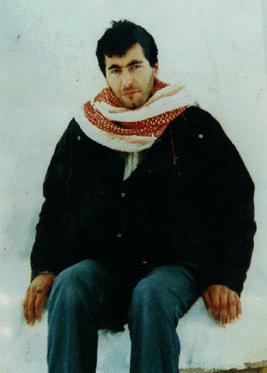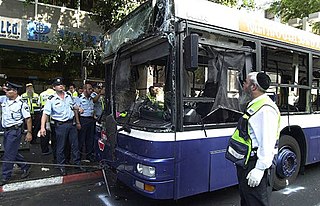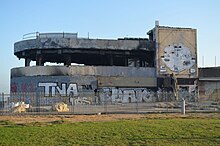
The Passover massacre was a suicide bombing carried out by Hamas at the Park Hotel in Netanya, Israel on 27 March 2002, during a Passover seder. 30 civilians were killed in the attack and 140 were injured. It was the deadliest attack against Israeli civilians during the Second Intifada.

Yahya Abd-al-Latif Ayyash was the chief bombmaker of Hamas and the leader of the West Bank battalion of the Izz ad-Din al-Qassam Brigades. In that capacity, he earned the nickname "the Engineer". Ayyash is credited with advancing the technique of suicide bombing in the Israeli–Palestinian conflict. The bombings he orchestrated killed approximately 90 Israelis, many of them civilians. He was assassinated by Shin Bet on 5 January 1996.

Shevah Mofet, also transliterated Shevach Moffet, is a junior and high school on HaMasger Street in Tel Aviv, Israel. It was established in 1946 as a vocational school. Since the 1990s, new programs were inaugurated to meet the needs of the Russian immigrant population in Israel.

Palestinian political violence refers to actions carried out by Palestinians with the intent to achieve political objectives that can involve the use of force, some of which are considered acts of terror, and often carried out in the context of the Israeli–Palestinian conflict and the Israeli occupation. Common objectives of political violence by Palestinian groups include self-determination in and sovereignty over Palestine, or the "liberation of Palestine" and recognition of a Palestinian state, either in place of both Israel and the Palestinian territories, or solely in the Palestinian territories. This includes the objective of ending the Israeli occupation. Some of the factions have called for the destruction of the state of Israel. More limited goals include the release of Palestinian prisoners or the Palestinian right of return.
Note: This compilation includes only those attacks on Israelis that resulted in casualties and no Palestinian deaths are recorded. Numerous other attacks which failed to kill, maim, or wound are not included.
The following is a partial list of civilian casualties in the Second Intifada.

Israeli casualties of war, in addition to those of Israel's nine major wars, include 9,745 soldiers and security forces personnel killed in "miscellaneous engagements and terrorist attacks", which includes security forces members killed during military operations, by fighting crime, natural disasters, diseases, traffic or labor accidents and disabled veterans whose disabilities contributed to their deaths. Between 1948 and 1997, 20,093 Israeli soldiers were killed in combat, 75,000 Israelis were wounded, and nearly 100,000 Israelis were considered disabled army veterans. On the other hand, in 2010 Yom Hazikaron, Israel honored the memory of 22,684 Israeli soldiers and pre-Israeli Palestinian Jews killed since 1860 in the line of duty for the independence, preservation and protection of the nation, and 3,971 civilian terror victims. The memorial roll, in addition to IDF members deceased, also include fallen members of the Shin Bet security service, the Mossad intelligence service, the Israel Police, the Border Police, the Israel Prisons Service, other Israeli security forces, the pre-state Jewish underground, and the Jewish Brigade and the Jewish Legion.
Events in the year 2002 in Israel.
Events in the year 2001 in Israel.

The 2002 Herzliya bombing took place on June 11, 2002, when a Palestinian suicide bomber set off a bomb at the Jamil restaurant in the Israeli beach suburb of Herzliya. The event resulted in the death of one teenager, Hadar Hershkowitz, and the injury of 15 people. The attack led Israel to lodge a formal complaint with the UN security council, citing it as evidence for a "campaign of Palestinian terrorism" against Israeli civilians.
Events in the year 2001 in the Palestinian territories.
On 25 January 2002, a Palestinian suicide bomber injured at least 24 civilians in Tel Aviv, Israel. Afterwards, the Islamist Palestinian militant organization Islamic Jihad claimed responsibility.

The Netanya Market bombing was a suicide bombing which occurred on 19 May 2002 at the entrance to the main fruit and vegetable open-air market in Netanya, Israel. The site of the attack was chosen in order to cause maximum number of casualties. Three people were killed in the attack, and 56–59 were injured.

The Allenby Street bus bombing was a suicide bombing that occurred on September 19, 2002 on a Dan bus in the center of Tel Aviv's business district. Six civilians were killed in the attack and approximately 70 were injured. Hamas claimed responsibility for the attack.
The Carmel Market bombing was a suicide bombing which occurred on 1 November 2004 at the Carmel Market located at the heart of Tel Aviv's business district. Three civilians were killed in the attack and over 50 people were injured.
Husam Badran is the former leader of Hamas’s military wing in the northern West Bank. He was the orchestrator of several suicide bombings during the Second Intifada with the highest number of fatalities including the 2001 bombing which resulted in the Dolphinarium discotheque massacre in Tel Aviv which killed 21 people. Currently Badran serves as the international spokesperson for Hamas using Twitter, Facebook, and news media to encourage Hamas militants to commit acts of political violence against Israelis and the Israeli government. He lives in Doha, Qatar.

In a terrorist attack in Tel Aviv, Israel on 8 June 2016, two Palestinian gunmen opened fire on patrons at the Max Brenner Cafe at the Sarona Market, killing four people and injuring seven others. The perpetrators were caught alive by the security forces and put in custody. According to an official indictment filed by the Tel Aviv District Prosecutor's Office the perpetrators were inspired by the Islamic State group.















